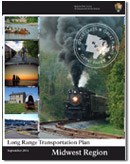Federal Lands Transportation Program Fact Sheets
Federal Lands Transportation Program (FLTP) Fact Sheets provide more information about topics and initiatives that the FLTP focuses on.Active Transportation
Economic Benefits of Transportation Investment
Emergency Relief for Federally Owned Roads Program
Environmental Benefits of Transit Systems
Pavement Preservation
Revegetation Program
Transit Partnerships
Transportation Asset Management
Transportation Safety
Visitor and Traveler Information Technology
Agreements
The 1983 Interagency Agreement between the National Park Service and the Federal Highway Administration is the current agreement between the two agencies outlining their roles and responsibilities.
Long Range Transportation Plans
The development of LRTPs involves high-level coordination with the Federal Highway Administration (FHWA), state departments of transportation, and Federal land management agencies, as well as input from state visitation and tourism organizations, to better understand regional and national demographic shifts and projected visitation trends. The Regional LRTPs are updated every five years.

Southeast Region Long Range Transportation Plan (9.3mb .pdf)

Midwest Region Long Range Transportation Plan (8.8mb .pdf)

Denali National Park and Preserve Long-Range Transportation Plan, March 2018 (12.5mb .pdf)

Policy
The purpose of this updated FLTP Policy is to provide consistent, strategic direction for the NPS to achieve its transportation priorities and funding needs. This update of the FLTP Policy, coinciding with the BIL, is important to inform how the FLTP pivots to address today’s challenges, accomplishes this Administration’s focus areas, continues within the framework of the current NPS National Long Range Transportation Plan (National LRTP), and aggressively seeks to leverage opportunities from other fund sources to best invest in multimodal transportation needs.
Manuals, Handbooks, Toolkits, and Guides
NPS FLTP Implementation Guide - This guide is intended as a ready reference to the program and project management processes of the National Park Service Federal Lands Transportation Program (NPS FLTP), a jointly administered transportation program of the National Park Service (NPS) and the Federal Highway Administration (FHWA). This guidance document provides information on roles and responsibilities, goals, policies, planning, coordination, fund sources, budgeting, programming, project development, and project delivery.Park Road Standards - There are two versions of the Park Road Standards available for your reference. In 1967, Director George B. Hartzog, Jr. assembled a group of notable individuals to help provide the answers to these basic questions: What is a park road? When, where, how and why do we build a park road? And under what circumstances do we consider adoption of other means of transportation? The 1968 Park Road Standards set out the basic philosophy of park roads and was a foundation to the current Park Road Standards. In 1984, a Task Force updated and expanded the 1984 Park Road Standards and these standards are still in effect.
Park Road Standards - 1968
(PDF | 938Kb)Park Road Standards - 1984
(PDF | 7.08Mb)
Managing Congestion: A Toolkit for Parks (pdf | 5.7 mB) — December 2020
Traffic congestion and visitor use patterns are evolving at national parks. Once traffic congestion is persistent, a park enters a new management era, requiring a new, holistic approach. A balance of operational changes, adjusting capacity (or using existing capacity more effectively), and adding capital investments/new services help parks invest wisely and minimize unintended consequences. The 2020 revised toolkit offers parks a variety of choices to improve congestion management, featuring over 40 tools across nine categories.
National Park Service National Transit Inventory and Performance Report Archives
2023 (pdf | 835 KB)2022 (pdf | 5.1 mB)
2021 (pdf | 3.6 mB)
2020 (pdf | 4.2 mB)
2019 (pdf | 2.9 mB)
2018 (pdf | 4.7 mB)
2017 (pdf | 6.7 mB)
2016 (pdf | 5 mB)
2015 (pdf | 6.6mB)
2014 (pdf | 1.5 mB)
2013 (pdf | 1.6mB)
2012 (pdf | .74mB)
Last updated: April 8, 2025

